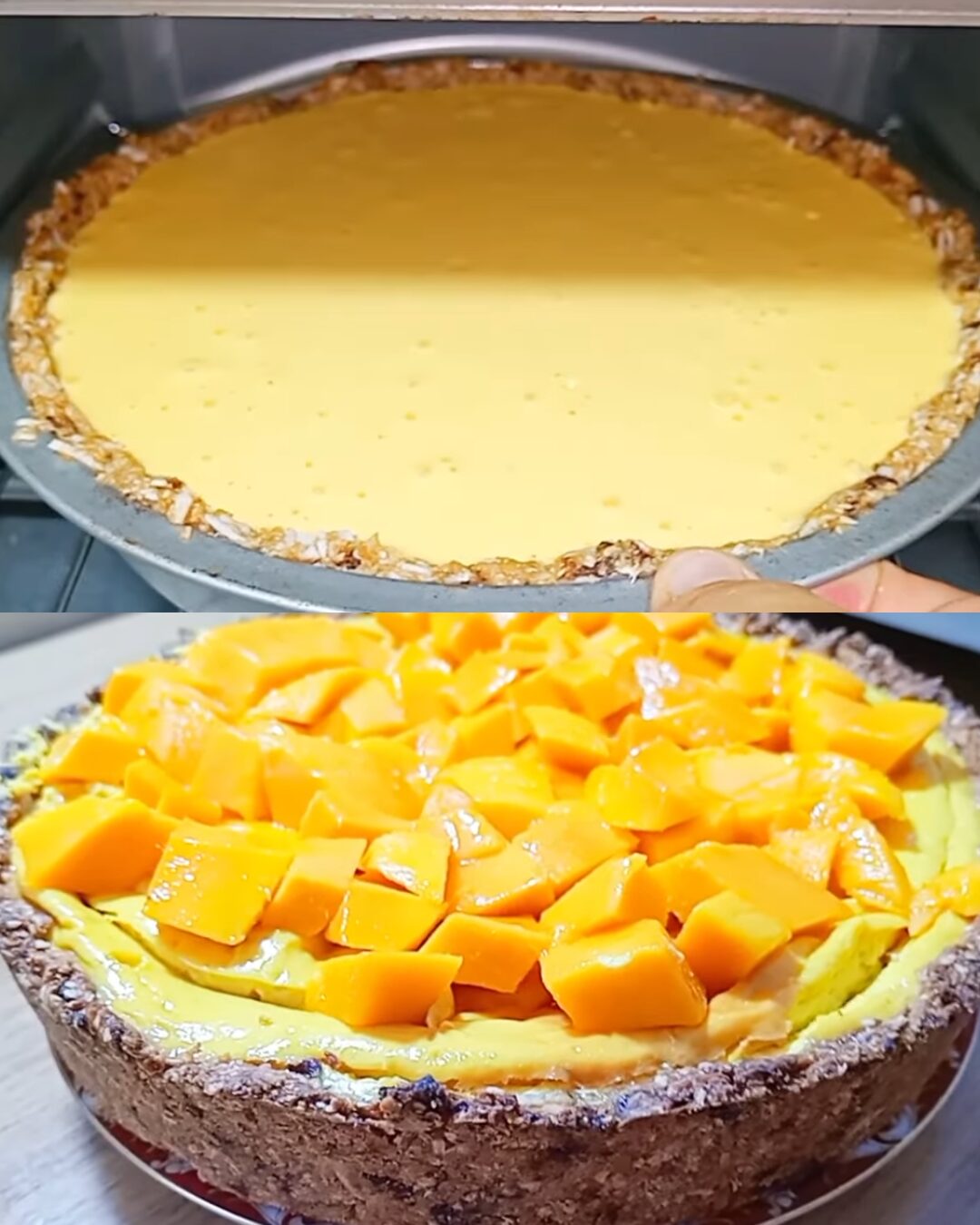If you’re craving a dessert that’s creamy, tropical, and satisfyingly sweet—but without the guilt—this Healthy Mango Cheesecake is exactly what you need. With a chewy oat and coconut crust, a light yet rich mango-yogurt filling, and a no-refined-sugar approach, it’s the kind of treat you’ll want to make again and again.
This recipe skips processed ingredients and uses natural, wholesome alternatives to deliver both flavor and nutrition. It’s easy to prepare, perfect for hot weather, and versatile enough to tweak based on what you have in your kitchen. Whether you’re serving guests or just treating yourself to a slice of sunshine, this mango cheesecake is guaranteed to brighten your day.
Preparation Time
Prep time: 20 minutes
Cook time: 50–55 minutes
Cooling and chill time: 1 hour
Total time: 2 hours 15 minutes
Yield
Servings: 8 slices
Serving size: 1 slice
Cuisine
Healthy fusion, with tropical and wholesome influences
Ingredients
For the crust:
1 cup ground oats (or oat flour)
9 pitted prunes (can also use Medjool dates or raisins)
1 cup unsweetened shredded coconut
1 teaspoon baking powder
1 egg
⅛ cup (30 ml) coconut oil (substitute with olive oil or avocado oil if preferred)
For the mango cheesecake filling:
1 cup fresh mango chunks (Ataulfo mango is ideal for its sweetness)
190 grams (approx. 6.7 oz) low-fat cream cheese (or substitute with ricotta or Greek yogurt)
3 large eggs
2 tablespoons honey (or agave syrup, maple syrup, or your favorite liquid sweetener)
⅓ cup unsweetened natural yogurt (can use Greek or plant-based yogurt)
Optional topping:
Additional diced fresh mango for garnish
Instructions
1. Prepare the Crust
Start by setting up your base. This oat and coconut crust is naturally sweetened with prunes and provides a chewy, satisfying texture.
Add the following to a food processor: 1 cup of ground oats, 9 pitted prunes, 1 cup shredded coconut, and 1 teaspoon baking powder. Pulse a few times to break down the prunes and mix everything together.
Add 1 egg and ⅛ cup (30 ml) coconut oil. Blend until the mixture forms a coarse dough that holds together when pressed.
Line the bottom of a round cake pan (about 8 inches or 20 cm) with parchment paper and lightly grease the sides.
Press the crust mixture firmly into the base of the pan, spreading it evenly to ensure the same thickness throughout. Set aside while you prepare the filling.
2. Make the Mango Cheesecake Filling
This silky filling is loaded with tropical mango flavor, creamy cheese, and a hint of honey for sweetness.
In a blender or food processor, combine 1 cup chopped fresh mango, 190 grams low-fat cream cheese, 3 eggs, 2 tablespoons honey, and ⅓ cup plain yogurt. Blend until the mixture is smooth, creamy, and fully combined. There should be no lumps.
Taste and adjust sweetness if desired.
3. Assemble and Bake
Pour the mango filling over the prepared crust. Tap the pan gently on the counter to remove any air bubbles and level the surface.
Bake in a preheated oven at 180°C (350°F) for 50 to 55 minutes, or until the top is set, golden in places, and a toothpick inserted in the center comes out mostly clean with a few moist crumbs.
4. Cool and Chill
Let the cheesecake cool at room temperature for 15–20 minutes. Once it’s no longer hot, transfer it to the fridge and chill for at least 1 hour, preferably 2–3 hours or overnight for best results.
5. Decorate and Serve
Before serving, top the cheesecake with fresh diced mango or your favorite fruit. Slice and serve cold. Enjoy!
Nutritional Information (per slice, approx.)
Calories: 210
Protein: 6 g
Fat: 13 g
Carbohydrates: 19 g
Sugar: 9 g (from natural sources: mango, prunes, honey)
Fiber: 3 g
Cholesterol: 55 mg
Sodium: 110 mg
Note: These values are estimates and may vary based on exact ingredients used.
The Origin and Popularity of Cheesecake
Cheesecake has roots dating back to ancient Greece, where it was served to athletes during the first Olympic Games in 776 B.C. The classic New York-style cheesecake we know today became popular in the 20th century, relying heavily on cream cheese, eggs, and sugar. While undeniably delicious, traditional cheesecakes are also dense and calorie-rich.
This modern, healthier version replaces refined sugars and heavy cream with natural sweeteners, yogurt, and fruit. It caters to contemporary dietary trends while maintaining the indulgent, creamy essence of a classic cheesecake.
Why You’ll Love This Recipe
Wholesome Ingredients: Made with oats, coconut, yogurt, and fruit—no white flour or processed sugar.
Naturally Sweetened: Prunes and honey bring sweetness without overloading your system.
Tropical Flavor: Mango adds natural sweetness and vibrant color.
Lighter Texture: Thanks to yogurt and low-fat cream cheese, it’s creamy without being heavy.
Easy to Customize: Adaptable to what you have on hand or your dietary needs.
Health Benefits
This cheesecake doesn’t just taste good—it feels good to eat.
Oats provide fiber, which supports digestion and helps lower cholesterol.
Coconut offers healthy fats and adds richness without dairy.
Prunes are full of antioxidants and natural sugars for energy.
Mangoes are rich in vitamin A, vitamin C, and beta-carotene.
Yogurt supports gut health with beneficial probiotics.
Honey offers antibacterial properties and trace minerals.
Serving Suggestions
Serve with a sprig of mint and a dollop of coconut whipped cream.
Drizzle with passionfruit puree or a spoonful of mango compote.
For brunch: Pair a slice with a smoothie bowl or fresh fruit salad.
For dessert: Serve with a cup of green tea or lightly sweetened iced coffee.
Expert Cooking Tips
No food processor? Chop prunes finely and mix by hand with oat flour and coconut.
No mango? Substitute with peaches, papaya, or even cooked sweet potato for a similar consistency.
Want a vegan version? Use flax eggs, plant-based yogurt, and vegan cream cheese.
Need extra sweetness? Add a few drops of stevia or another tablespoon of honey.
Flavor Variations
Berry Cheesecake: Replace mango with fresh or frozen blueberries or strawberries.
Chocolate Coconut: Add 1 tablespoon cocoa powder to the crust for a chocolaty base.
Lemon Mango: Add 1 tablespoon lemon juice and zest to the filling for a citrusy note.
Spiced Cheesecake: Add a pinch of cardamom or cinnamon to the crust or filling for warm depth.
Storage Instructions
Store in an airtight container in the fridge for up to 4 days.
Freezing: Wrap individual slices and freeze for up to 1 month. Thaw in the fridge before serving.
Conclusion
This Healthy Mango Cheesecake with Oat and Coconut Crust is proof that dessert can be delicious and nourishing. With no refined sugar, gluten-free ingredients, and a simple step-by-step method, it’s the perfect guilt-free indulgence. Whether you’re hosting a summer gathering or just want something special for your family, this recipe brings both nutrition and joy to the table. Try it once, and it just might become your new favorite healthy treat.
FAQ
1. Can I make this recipe vegan?
Yes. Replace the egg with a flax egg (1 tbsp ground flax + 3 tbsp water), use plant-based yogurt, and vegan cream cheese.
2. Can I use frozen mango?
Yes, thaw and drain it first to remove excess moisture before blending.
3. What size pan should I use?
An 8-inch (20 cm) round pan or springform pan works well.
Advertisement
4. Can I skip the coconut in the crust?
Yes, substitute with almond meal or extra oats if needed.
5. Is it okay to use Greek yogurt?
Absolutely! It gives a thicker, tangier filling.
6. What sweeteners work besides honey?
Try agave syrup, maple syrup, or even date syrup for natural alternatives.
7. How do I know when it’s done baking?
The top should be slightly golden and mostly firm, with a little jiggle in the center.
8. Can I serve this warm?
It’s best served chilled after it sets, but can be eaten warm if you prefer a custardy texture.
9. Is this cheesecake suitable for diabetics?
It’s lower in sugar than traditional versions, but consult with your doctor for personal dietary advice.
10. Can I double the recipe?
Yes, but use a larger pan and increase baking time by 10–15 minutes, checking for doneness.

